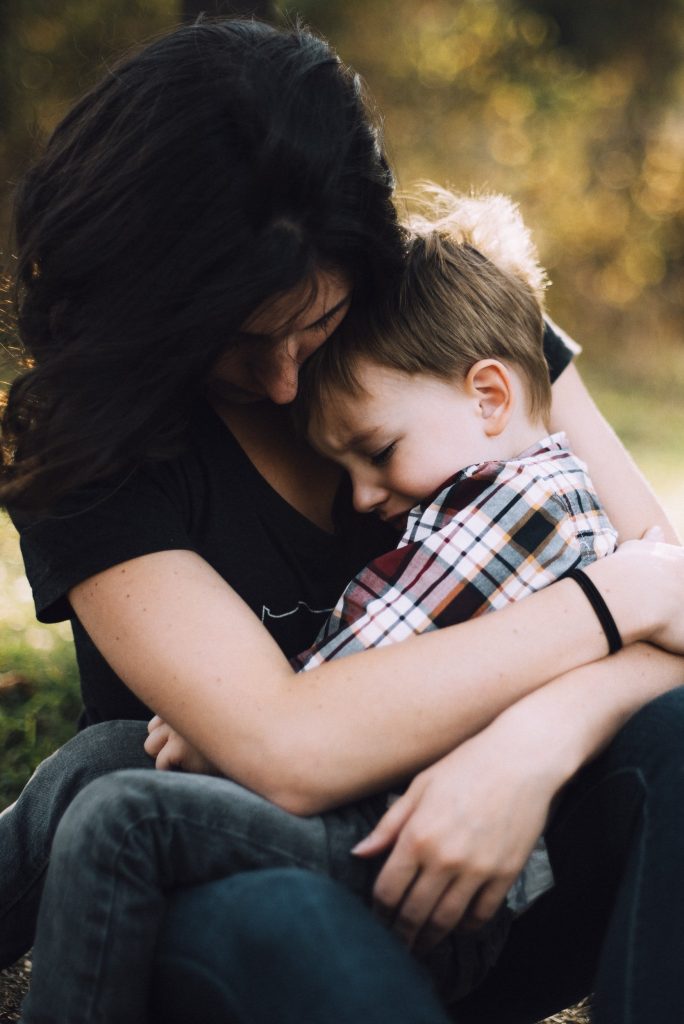Teaching the 4 Big Skills™ to Your Child During Divorce

Teaching the 4 Big Skills™ to Your Child During Divorce ©2020 Bill Eddy, LCSW, Esq. Divorce and separation are times of stress for both parents and children. Parents often don’t know how to talk to their children about divorce, living in two homes, rules and traditions with separated parents, and other new ways of operating. This course was designed to help parents start these difficult conversations. Building on what the parent has already learned in the New Ways for Families online course, this course focuses on conversations that the parents can have directly with their child. Now that the parent themselves has learned The 4 BIG Skills™, they are in a better position to talk to their child about the divorce or separation, role modeling appropriate behavior and using appropriate language. *Note: the New Ways for Families online course is a prerequisite to the Parent-Child course. Parents first learn the skills in the New Ways for Families course, then teach those same skills to their children in the Parent-Child course. Skills for Children Teaching children these skills will help him or her solve problems in everyday life, at school, with friends, with family members, as well as to cope with stressful circumstances related to divorce or separation. Today, more than ever before, children face rapidly changing times in a rapidly shrinking world. Conflict and change is inevitable. The children who will be most successful in the future will be those who grow up with the most solid foundation of skills – to keep learning and improving what they do. The 4 BIG Skills help children deal with specific family problems, such as divorce or separation. These are also good relationship skills, work skills and leadership skills. This course gives parents many opportunities to practice talking to their children about these issues and demonstrating the skills. The 4 BIG Skills™ flexible thinking (acknowledging that there is more than one solution to a problem, acknowledging that people are not “all-bad” or “all-good”) managed emotions (controlling one’s anger, sadness, fear, and anxiety; learning to calm oneself when upset) moderate behaviors (avoiding extreme actions) checking yourself (reminding yourself to use these skills when you feel yourself getting upset) Course Goals This online course is designed to: Teach the child to use The 4 BIG Skills™ during this time of rapid change Make the parent-child relationship stronger and less stressful, opening the door for honest and supportive conversation about the future Help the parent guide their child through this time of transition with less stress, less anxiety, and a more stable foundation for moving forward Parents should think of this class as helping them to feel confident in teaching their child to be resilient no matter what problems he or she faces in the future. Course Activities Teaching the 4 Big Skills: This course includes activities that parents can do with their child throughout each of the classes, with each class focused on one skill. The course provides lots of tips for easy ways to teach children these concepts. Many of the activities will focus on helping the child with a simple activity, such as putting pictures from magazines into a scrapbook or on a paper bag with examples of children and adults using these skills. The activities will help the parent discuss with the child which behaviors are okay (moderate behavior) in a situation and which behaviors are not acceptable (extreme behavior). Sample Language: The course includes examples of words parents can use to explain concepts to their child, and questions parents can ask their child to help get these discussions going. The Five General Age Groups: All activities, discussion questions, sample language, and examples are provided for each of the following age groups: 0-3 years 4-6 years 7-11 years 12-17 years 18-25 years Course Outline Unit 1: The 4 Big Skills for Life Parent-Child Talk Living in Two Houses Children in the Middle Extreme Behaviors Managing our Emotions Flexible Thinking Rules in Both Houses Age Appropriate Tips Talking to Your Co-Parent Unit 2: Managed Emotions Benefits of Managed Emotions Ways to Manage Emotions Calming Intense Emotions Emotions are Contagious Age Appropriate Tips Managing Emotions with your Co-Parent Unit 3: Flexible Thinking All-or-Nothing Thinking Your Child’s Thoughts Solving Problems In Divorce/Separation Making Proposals Changes in Your Family Age Appropriate Tips Using Flexible Thinking with your Co-Parent Unit 4: Moderate Behavior Regretting Extreme Behaviors Trying Moderate Behaviors New Behaviors with the Other Parent Checking Yourself Age Appropriate Tips Moderate Behaviors with your Co-Parent Explore more about the New Ways for Families class and coaching here. BILL EDDY, LCSW, ESQ. is the co-founder and Chief Innovation Officer of the High Conflict Institute in San Diego, California. He pioneered the High Conflict Personality Theory (HCP) and is viewed globally as the leading expert on managing disputes involving people with high conflict personalities. He has written more than twenty books on the topic and has taught professionals in the U.S. and more than ten countries. He is also the co-host of the podcast, It’s All Your Fault!
Understanding Polarization in Families, Groups, and Nations

Understanding Polarization in Families, Groups, and Nations ©2020 Bill Eddy, LCSW, Esq. There is much talk today about polarization. Ironically, few people put together the fact that the same process is driving three seemingly unrelated problems. By understanding what is really going on, we should be able to significantly reduce this polarization in our families, groups and nations. Child Alienation In many divorcing families (maybe 10-15%), a child is resisting or refusing contact with one of their parents and sees the other parent in ideal terms. This polarization can expand rapidly by the child rejecting grandparents, former family friends and even pets at the rejected parent’s house. Professionals and courts often call this “alienation” and it often grows into what some have called “tribal warfare.” People line up on one side in agreement with the child’s rejection of the other parent (he or she must have done something wrong) and the rejected parent’s people line up on the other side (the favored parent must be alienating the child). They frequently argue with each other, emotions escalate, and some involved start hating each other. Professional Splitting In mental health hospitals and substance abuse treatment programs, a phenomenon has been occurring for years often known as “staff splitting.” This commonly occurs when a treatment team is working with a patient with a personality disorder, such as borderline personality disorder. Generally, half the team lines up on the side of higher expectations, more structure and more consequences for the negative behavior of the patient. The other half tends to argue for lower expectations, more tolerance and more understanding of the patient’s problems. They frequently argue with each other, emotions escalate, and some involved start hating each other. The same phenomenon sometimes occurs in University Departments, legal disputes, religious institutions, and many other work settings. Political Polarization In the United States, England, and several other countries, newscasters and political analysts state almost every day that the country is “deeply polarized.” Almost half of the country supports the president and defends whatever he is doing, in terms of his policies, his personal behavior, and his outrageous comments against the establishment and for his team. And almost half of the country opposes the president and is angry with whatever he is doing, in terms of his policies, his personal behavior, and his outrageous statements. These two sides constantly argue with each other, emotions escalate, and some involved start hating each other. So, what’s going on here? And why are these three seemingly unrelated situations demonstrating the exact same dynamics? Is there a common element or elements? Emotional Repetition in Isolation (ERII) The engine of polarization in each of these settings appears to be emotional repetition in isolation. It’s important to know that polarization is an emotional phenomenon, not a logical phenomenon. Emotions Intense emotions grab our brain (especially the amygdala) in a way that declares an emergency and shuts down our logical thinking. An excess of intense emotions triggers anxiety and an inability to manage our emotions. Unmanaged emotions can quickly become contagious, so that when one person exhibits unmanaged and intense emotions, a whole group can start to exhibit heightened emotions, especially including anxiety and anger. When someone often speaks in terms of conflicts, crises, chaos, fear and anger, all of these high-conflict emotions are highly contagious In divorces, intense emotions are often seen as related to the divorce. But for some, the intensity of their emotions is a symptom of their own problems, not usually someone else’s behavior. “The issue’s not the issue, the personality is the issue.” But many professionals don’t understand this and absolutely believe that something terrible must have been done to an upset child by the other party, especially child abuse, sexual abuse or intentional alienation. The result is that in cases with an anxious child, but no evidence of abusive behavior, professionals become split over the case and more emotional too. The emotional level increases with time and with each court decision that doesn’t address the real problem (the need for self-management skills training for the person(s) with a high-conflict personality). In professional groups, being on two teams can create extreme behavior. An excellent example of emotions taking over was the O.J. Simpson criminal trial in which the lawyers on each side grew to hate each other. Both sides brought ethics complaints against the other side’s lawyers for their “all-bad” behavior, which were all eventually thrown out. There are many other examples, even in sports. Historically, there was the tragic case of two teams of chariot racers in the ancient city of Constantinople in the Roman Empire in the sixth century A.D. One group wore blue outfits and the others wore green. Apparently, emotions got so high (including the exaggeration of political and religious differences) that there was a riot between the teams that resulted in the deaths of 3000 blues and over 30,000 greens. Today’s riots after soccer matches just don’t compare. In politics, we are increasingly seeing candidates for offices at all levels speaking in highly emotional and extreme terms. Candidates with narcissistic personality traits or sociopathic personality traits lack the normal restraints of empathy and remorse, so that they can exaggerate and lie freely. And when political leaders speak in emotionally disparaging terms, there are always some people who will become emotionally hooked and possibly take dangerous actions in response. It’s the hyped-up emotions that seem to drive these events. Repetition The way our brains work, repetition strengthens ideas, behavior, and emotions—especially a sense of danger in our amygdala. It’s for our own protection. Today, we are all exposed to more emotional intensity in all three of the settings described above, legal disputes, family disputes and workplace disputes. The reasons vary by the setting. Our legal system protects extremely emotional statements and behavior when they are part of the legal process. Our workplace standards protect them when it’s part of the innovation process. Our political system protects them when it’s part of the political
High Conflict Christmas In Two Homes Survival Guide

High Conflict Christmas in Two Homes Survival Guide ©2019 Andrea LaRochelle, RFM Do you feel like your children are *missing out* by not spending time with both their parents on Christmas Day? Have your children become a pawn in your ongoing parental conflict and Christmas is just another example of that? When you are falling in love, planning your future and creating a family, rarely do you envision a plan for what might happen should the relationship fail. When you first had children, you mentally created a picture of what Christmas was going to look like for your family. That picture likely didn’t include sharing the holidays, alternating Christmas and New Year’s, not seeing your children open presents on December 25, Christmas in two homes. It wasn’t the picture your children mentally created for Christmas either. Ouch. Did that sting a little bit? Good. I wanted to make sure I got your attention; what I’m about to tell you is important. Often parents focus on what their children are missing out on rather than what they are feeling and needing. Parents worry about what they believe their children DESERVE rather than what their children NEED. The only thing children NEED at Christmas (and every day, for that matter) is to know that they are loved unconditionally, regardless of their parents’ inability to get along. You can’t change your reality, or your children’s reality. (Unless, of course, you and your children’s other parent are able to put your differences aside and celebrate Christmas together). You need to let go of your Christmas expectations from the past and start creating new Christmas traditions. Help your children create new magical Christmas memories, that they will look back on fondly. Christmas isn’t just a day celebrated on December 25th, Christmas is about the feelings and emotions we attach to the day. Those feelings and emotions can be created on any day of the year. Choose to let go of your attachment to December 25th, the day, and start creating the Christmas feelings and emotions you want your children to associate with the experience of Christmas. How the heck do you do that? 3 Steps to Letting Go of your Christmas Day Expectations for your Children Focus on what is important to your children, and why. Your children may ask for the newest & shiniest toy on the shelf at Toys R’ Us, but if you quiet yourself and really tune into their NEEDS, you may surprise yourself to learn what they really want. Generally, as long as their *mom* or *dad* is happy on the day Christmas is celebrated, then they are happy. Your happiness is what your children need and want for Christmas this year. Choose to put on a happy face and be present with your children this Christmas, on whatever day that might be and however Christmas might look this year. Focus on the memories you want your children to remember when reflecting on their childhood Christmas experiences with you. Your children are going to remember Christmas one of two ways – positively or negatively. You, and only you, can help shape the memories they will have around Christmas with you. Their other parent may take them to Disneyland, buy them expensive presents or, for one reason or another, put limits on how much time you are able to spend with your children at Christmas. You can’t change any of that. Those are memories, good or bad, their other parent is choosing to give your children. What memories can you help create? What feelings do you want your children to connect to their Christmas experience with you? “I’ve learned that people will forget what you said, people will forget what you did, but people will never forget how you made them feel.” — Maya Angelou Focus your time and energy on your children this Christmas. Parents often romanticize what Christmas is like for intact families; family board games by the fire, sledding & skating with hot chocolate afterwards, caroling while decorating the Christmas tree, laughs of joy Christmas morning. Intact families have their Christmas struggles too. They argue over who knotted the Christmas lights, who will take little Joey to the walk in clinic because he sprained his ankle sledding or skating. Intact families bicker through Christmas Day because the kids were up at 5am to see what Santa brought and 15 people are showing up for dinner. There is a difference between intact families and those who are apart. Children of intact families celebrate one Christmas with Santa, one Christmas dinner, one Christmas tree decorating adventure. Children of separated parents have the opportunity to experience not only two Christmas’s with Santa, two Christmas dinners and two Christmas tree decorating adventures; children of separated parents also experience one-on-one Christmas time with each parent. Cherish the time you have with your children this Christmas, whether it’s on December 25th or January 8th. Make Christmas special for your children. Focus your time and energy on your children this Christmas; I promise you, they will always look back fondly on their Christmas experiences with you. 5 New Christmas Traditions for Children with Two Homes Celebrate *half Christmas* on June 25th – Who decided Christmas had to be celebrated in December, anyway? The Great Annual *Christmas* Pancake Cook-off – Create memories through feelings and emotions, this can happen any day of the year!) The Annual Scrabble/Monopoly/Boardgame Challenge (8 hours of continuous Board games – thinks of the laughs to be had!!) The Annual Dollar Store Scavenger Hunt – Each family member gets $5 and 5 minutes to find the *perfect* holiday gag gift for everyone in their family OR each family member gets $5 and 5 minutes to find the perfect give to donate to a family in need. You can spin this many ways; What’s important is that you are doing it together, creating positive emotional memories for your children) The Christmas Card Craft Extravaganza – Spend a morning making Christmas Cards for your neighbors,
